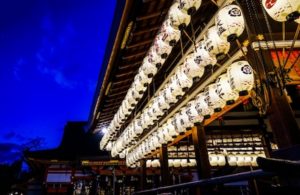Kyoto in July is completely dominated by the Gion Festival, one of the most famous festivals in all of Japan.
About 180,000 people visit this annual events though, not everyone knows its history.
This time, we’d like to explain some histories of Gion Festival to enjoy it more.
The History of Gion Festival

When Kyoto was the capital of Japan, during Heian Period (794), the people were suffered from a sequence of catastrophic including earthquake, tsunami, plague and epidemics.
As Kyoto people were devoted Shinto believers, under the fear, they organized parades, carrying portable statuaries (mioshi), and would decorate 66 halberds representing 66 old provinces.
At that time, it was believed that Aramitama (fierce divine spirit) or evil spirits would occur the catastrophes.
Therefore, people dedicated the rituals or pray to appease their spirits.
By medieval times, the Faith spread nationwide, Gion-sha Shrines or Gozu Ten’nō Shrines enshrining Gozu Tenno were built, and Goryo-e were held as celebrations.
Why is the festival held at Yasaka jinja Shrine?

Yasaka jinja Shrine is an important site for Gion Festival because it worships Gozu Ten’nō.
Gozu-Ten’nō is a guardian deity of Buddhism and is considered to be the same god as Susano’o-no-mikoto in Japan.
Gozu Tenno, which had been believed to bring diseases and misfortunes to people, was enshrined in Yasaka-jinja Shrine in Kyoto, giving birth to gion shinko.
The order for the separation of Buddhism and Shintoism in Meiji prohibited Buddhist rituals at shrines, as well as the use of Buddhist terms such as Gozu Ten’nō and Gion in names of enshrined deities and shrines, and thus, Gion jinja Shrine and Gozu- Ten’nō -sha Shrine became shrines enshrining Susanoo and changed their shrine’s name.
The Hardship of Gion Festival

Gion Festival has faced the crisis of continuance several time in its history.
The biggest crisis was the outbreak of Onin War in 1467 whish has been lasting for 11 years at the center of Kyoto.
It took thirty-three years to restart the Gion Festival after the War.
The festival was prohibited soon again by Enryakuji Temple because the religious struggle between Tendai sect and Jodoshinshu sect got fierce in 1533.
Of course, citizens protested this order and requested.
“We’d like to hold the Gion Festival even without prayer.”
This was the beginning of the Gion Festival led by Kyoto people.
Currently, Gion Festival is listed on UNESCO Representative List of Intangible Cultural Heritage of Humanity. And it can be appreciated by everyone for free. Just get yourself a nice spot and do not forget your camera and some water. The most recommended main parades are held on July 17th and 24th.
Do you need more information?
You should receive such local information of Kyoto by an application “KoI APP”.
With this application, even if you don’t have Wi-Fi, you can find nearby stores and so on.
You can install the application from the following URL.














